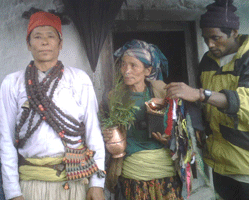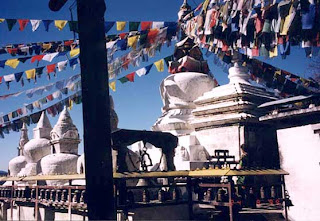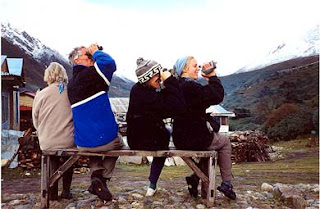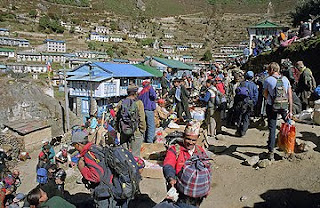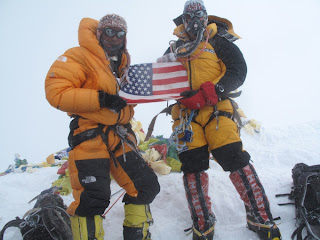About Kathmandu Valley (काठमांडौ) A 218 square miles of land, situated above 4400 ft above sea level with three historic, artistic and cultural towns namely Kathmandu, Patan and Bhaktapur together form what is known as the `Kathmandu Valley'. Kathmandu is the hub of Nepal's traditional culture and arts. This is the place for rest, relaxation and easy-day sightseeing of historic and artistic temples and monuments, and mountain views. Being the capital city of Nepal, it offers much services including international airlines, hotels and other facilities. One also enjoys Kathmandu for night life, shopping and of course for the mountain views. Getting to Kathmandu - Tribhuwan International Airport is located about 4 mile (7 kilomter) from Kathmandu. It takes about 20 minutes to get to Kathmandu from the airport by foot or about 10 minutes by cab. Shuttle buses and cabs of many hotels are available from the Airport or you can choose your own transportation for about Rs 200 (Approx US $3)
Pictures of Kathmandu Airport> Getting to Kathmandu by Air? How much will it cost? Mountains to see from Kathmandu: Following mountains can be seen from Kathmandu: Himal Chuli 7893m, Manaslu 8156m, Pabil GIV 7102m, Ganesh II 7150m, Ganesh V 6950 m, Lang tang 7246m, Gang Chhenpo 6297m, Sisa Pangma 8013m, Gur Karpori 6874m Dorje Lhakpa 6790m, Gyaltzen PK 6705m, Phurbi Chyachu 6722m, Kharane Tippa 5674m, Choba Bhamare 5970m, Choo-yu 8153m, Gauri Shankar 7145m, Melungtse 7181m, Lindartsubugo 6690m, Mt. Everest 8848m, Chobutse 6660m, Takargo 6782m.
View some pictures of mountains in Nepal When you visit Nepal, visit the following places in the Kathmandu Valley.
Places to Visit in Kathmandu
Swayambhu:
The history of Kathmandu valley begins from the Swayambhu temple. This valley was a lake, but later when Bodhisattva Manjusri cut a gorge in a southern hill and drained the waters to worship a lotus that he admired during his travel to the region, it lead men to settle on the bed of the lake and named this land Kathmandu Valley. The word Swayambhu means "the self-existent" in English. Today this complex of stupas offers an opportunity to study the religious harmony in Nepal. Tibetan monks, Brahimn priests and Newar nuns are the major worshipers here. Most of the monasteries have huge prayer wheels, fine Buddhist paintings and special butter lamps all add an elegant touch to the Swayambhu.
Photos of SwayambhuWhen you visit Nepal, visit the following places in the Kathmandu Valley.
Places to Visit in Kathmandu
Swayambhu:
The history of Kathmandu valley begins from the Swayambhu temple. This valley was a lake, but later when Bodhisattva Manjusri cut a gorge in a southern hill and drained the waters to worship a lotus that he admired during his travel to the region, it lead men to settle on the bed of the lake and named this land Kathmandu Valley. The word Swayambhu means "the self-existent" in English. Today this complex of stupas offers an opportunity to study the religious harmony in Nepal. Tibetan monks, Brahimn priests and Newar nuns are the major worshipers here. Most of the monasteries have huge prayer wheels, fine Buddhist paintings and special butter lamps all add an elegant touch to the Swayambhu.
Photos of Swayambhu Pashupati:
When Lord Shiva came to Pashupati to escape from his boredom, he became famous as the lord of Animals (Pashupati) Today, millions of Hindu pilgrimage pour into this temple. Many Hindus from Indian sub contents, Nepal, Pakistan, Asia come to Pahsupati to pay their respects to the lord Shiva. From other parts of the world, many Hindus come to Pashupati to fulfill their dream of visiting the holiest Hindu pilgrimage in the world. You can see the pagoda house which has gold-plated roof, silver doors and find woodcarvings. The linga (phallic symbol) of Lord Shiva, his images, statues, and Bagmati river that flows beside it add to the holiness of Pashupati which lies just 1.5km from the international airport. The region is also surrounded by thick green jungle where monkeys and birds live and play and are often seen in large groups playing on the pavements of the temples in Pashupati. Sadhus who follow the life style of Shiva are found in Pashupati region. They paint their bodies with ashes, wear loin-cloths, Tika, and Rudraksha Malas.
Changu Narayan:
The temple, situated at Chingu village 12 km to the eat of the city, is fully dedicated to the Hindu God Vishnu (the god of creation). The temple is believed to be the most ancient temple in the Kathmandu valley. The temple covers over sixteen hundred years of Nepalese art history presenting some of the best samples of stone, wood and metal craft in Nepal. There is also everyone's favorite statue of Vishnu sitting astride his steed. For a view of the ancient arts this is a must see place.
Bouddhanath Stupa:
The 36 meter tall, among the largest stupas in South Asia, is a home to Tibetan Buddhism in Nepal. It is situated on the ancient trade route to Tibet (6km to the east of the city). For shopping, the area is a bazaar of Tibetan jewelry, hand made carpets, masks, kukuri knives (the knives used by Gorkhas) and Tibetan paintings known as thangkas. There are many stupas in the nearby surroundings all of which deserve a through observations by visitors.
View Pictures of BouddhanathKathmandu Durbar Square:
This is a durbar of history and arts. One can see artistic monuments, find the house of the living goddess, learn about the Kal Bhairam temple, red monkey god, and hundreds of erotic wood carvings. The kastamandap rest house located within the durbar square is said to have been built from a single tree, it is because of this house, Kathmandu valley got its name. There is also a museum located at the Durbar Square which presents a complete history of Nepal's King and Rulers.
Half-Day Itineraries for Kathmandu Valley:These are some of the half-day itineraries offered by most travel agents in Nepal. One can hire a car or a take the bus, with or without a guide can have splendid time in any of the following itineraries.
Kathmandu Dubar Square, Swayambhu
Kathmandu and Patan Durbar Square
Kathmandu Durbar Sqaure, Pashupatinath
Pashupati, Bouddha, Bhaktapur
Thimi, Bhaktapur
Pashupati, Bouddha, Changu Narayan
Changu Narayan, Sankhu
Balaju, Budhanilkantha
Kritipur, Chobhar and Dakshinkali
Kathmandu Durbar Square, Ason, Pasupatinath, Bouddha

